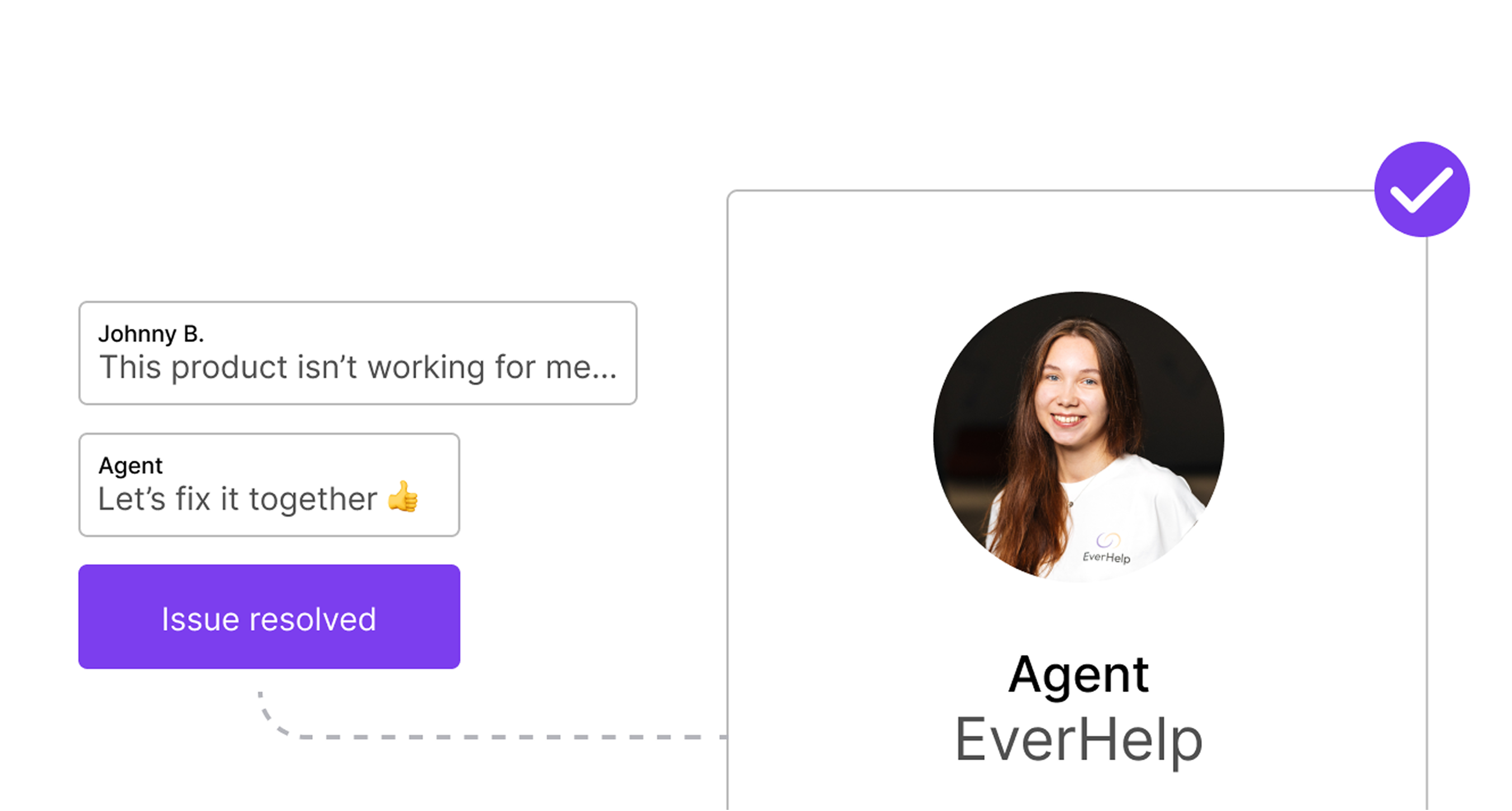9 Ecommerce Customer Service Mistakes That Will Cost You Dearly

A simple question "What's your order number?" may seem innocent. But, in reality, it can spark frustration in customers. In fact, it may be the very reason they don't come back, signalling customer churn prediction.
We've all experienced it.
You find the perfect product online, but customer service fails and you encounter a frustrating interaction with customer support. As a business owner, these minor customer service mistakes can cost you dearly. That's why customer service outsourcing services aim to prevent them.
Unrealistic delivery promises (or trust killer)
Customer support agents are often taught to promise very short delivery times. They do this to impress customers.
Sure, promising very fast delivery might win you a sale at first. But when that package gets delayed, it's not a missed deadline - it's a broken trust. Customers wait on overdue orders. And people are more sensitive to losses than gains (loss aversion). A missed delivery feels like a loss of control. It's the fast delivery they were promised. That’s why customers are far less likely to return for future purchases.
Instead, it's better to under-promise and over-deliver. This way, you will not disappoint those who get their orders on time. And you will delight those who get their orders early. Zappos is well-known for this. Their strategy of surprising customers is described in the book “Delivering Happiness”

Giving vague details about the product (“one size fits all")
If a customer asks a support agent which size a sweater is, and gets the reponse "one size fits all"... well, then you’re setting yourself up for trouble (or show the customer “I don’t care”).
Poor customer service example:

A one-size-fits-all answer might seem convenient, but it exposes a critical knowledge gap in your customer service. And let's be honest. Not everyone is the same size. There's a good chance that a one-size-fits-all sweater won't fit your customer.
When a customer asks about sizing, they're not just curious. They're trying to avoid the hassle (and cost) of returns. Invest in educating every support agent on product specifics. Empower them to give detailed information. This builds trust and cuts returns, protecting your profits.
Also, the IKEA effect suggests that people value things more if they invest effort into them. For instance, by researching sizing. They may feel like their effort is wasted due to a lack of information.
This will make customers anxious. They'll worry if the sweater will fit. It may also lead to many returns and lost customers.
No post-purchase proactive outreach
In eCommerce, it is very important to think through the moment after payment is made. After a customer hits "pay," they've entrusted you with their hard-earned cash.
After a purchase, silence creates uncertainty and frustration. It makes customers feel out of control. And this prompts them to contact support to regain control.
Write clear post-purchase communication. It should outline the next steps and manage expectations. This will reduce the burden on your support team. Proactive communication after the sale feels like a favor, fostering a positive customer relationship. Even automated messages sent from customer support agents are enough to meet the need for post-purchase connection.
Being uninformed about money matters
When returning money, customers often have to wait a certain number of days. This raises questions.
Imagine waiting weeks for a refund with no clear explanation - a recipe for customer churn. Empower your support team to confidently explain refund timelines and processes. Transparency fosters trust and reduces customer frustration.
Asking customers for info like “what’s your order number”
Order numbers (and other key order data) are usually long and complex. They are hard to remember and write down, especially from a phone. The support team should have this info in advance. A smooth experience keeps customers happy and reduces support workload.
Poor customer service example:

The problem is that people avoid tasks that need a lot of mental effort. Forcing customers to search for order numbers creates cognitive overload and frustration. Also, mental overload can lead to decision errors. This increases the chance of customers abandoning their support request at all.
Inappropriate automation in chats and tickets
You automate the first customer message. You use positive, friendly phrases to keep things from going wrong. Yes, generic greetings might seem efficient. But they backfire when a customer reaches out with genuine frustration. The need for authenticity is strong. Customers want to interact with people who get their situation and can show empathy.

A cheerful "Hi there!" in response to a detailed complaint only deepens the customer's feeling of being unheard. We’re all emotional creatures. And a canned greeting in the face of frustration creates an emotional disconnect. It feels impersonal and inauthentic, deepening frustration.
Train your support team to tailor their responses. They should acknowledge concerns and offer real empathy. Excessive automation also often tires and annoys customers. And if you do use automated messages, keep them neutral.
Saying “I’m sorry, it’s out of stock” without alternatives
Telling a customer "I'm sorry, it's out of stock" is a missed opportunity to turn a negative into a positive. It leaves them frustrated. They have nowhere to use their buying power. This impersonal approach also disregards the customer's time and effort, creating a sense of finality and might discourage browsing. Instead, you can offer alternatives.
You can suggest similar products or provide waitlist options. Doing this shows the customer you value their business and encourages customers to stay engaged with your brand.
You can even go further and research availability in competitors. Here’s another inspirational quote from the book "Delivering Happiness:"

Not apologizing when customer service fails
Some support agents may worry that an apology will be seen as an admission of guilt. They fear it will lead to an angry outburst from the customer.
However, it works in a different way. Failing to apologize for mistakes can be a costly oversight in customer service (and your ecommerce business can easily become nominated for the worst customer service). A customer who encounters an issue and receives no apology will lose trust and satisfaction. They may also waste time or money due to the mistake.
This bad feeling is made worse by the lack of acknowledgment. It makes the customer feel that their experience doesn't matter. A sincere apology, as opposed to that, acknowledges their loss. It shows a willingness to make things right.
Even if you do everything right, there will still be times when you've made mistakes. When this happens, it's important to apologize to the customer and take steps to correct the mistake.
Trying to close the ticket ASAP
One of the most frustrating things for customers is when they feel like they are not being listened to. It sends a clear message: their issue isn't important.
Rushing to close support tickets can lead to customer churn instead, leading to customer dissatisfaction.
By prioritizing active listening and taking the time to address concerns thoroughly, you demonstrate that you value their business and their experience. This fulfills their need for belonging and fosters trust. Just think of the best customer service examples—Zappo's agent spent a record-breaking 10 hours on the phone with a customer, resulting in a sale of UGG shoes.
Bottom Line: don't let bad customer service disrupt your growth
By understanding the psychology behind customer frustration, and fixing these common mistakes, you can create a smooth and positive experience. This will build trust and loyalty. However, building a customer support team and avoiding bad customer service reviews takes a lot of money and skill.
Partnering with a leading eCommerce customer service outsourcing service like EverHelp solves this challenge. EverHelp's highly trained and experienced agents handle complex inquiries and beyond. They use cutting-edge technology to predict customer needs, personalize interactions, and streamline support. This enables you to focus on curating a competitive product selection and building a thriving online brand.




.webp)





.png)













.webp)
.webp)


.webp)










